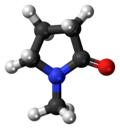Methylpyrrolidone
|
|
|||
| Names | |||
|---|---|---|---|
|
Preferred IUPAC name
1-Methylpyrrolidin-2-one
|
|||
| Other names
1-Methyl-2-pyrrolidone
N-Methylpyrrolidone N-Methylpyrrolidinone Pharmasolve |
|||
| Identifiers | |||
|
872-50-4 |
|||
| 3D model (Jmol) | Interactive image | ||
| ChEBI |
CHEBI:7307 |
||
| ChEMBL |
ChEMBL12543 |
||
| ChemSpider |
12814 |
||
| ECHA InfoCard | 100.011.662 | ||
| KEGG |
C11118 |
||
| PubChem | 13387 | ||
| UNII |
JR9CE63FPM |
||
|
|||
|
|||
| Properties | |||
| C5H9NO | |||
| Molar mass | 99.13 g·mol−1 | ||
| Density | 1.028 g/cm3 | ||
| Melting point | −24 °C (−11 °F; 249 K) | ||
| Boiling point | 202 to 204 °C (396 to 399 °F; 475 to 477 K) | ||
| Hazards | |||
| NFPA 704 | |||
|
Except where otherwise noted, data are given for materials in their standard state (at 25 °C [77 °F], 100 kPa).
|
|||
|
|
|||
| Infobox references | |||
N-Methyl-2-pyrrolidone (NMP) is an organic compound consisting of a 5-membered lactam. It is a colorless liquid, although impure samples can appear yellow. It is miscible with water and with most common organic solvents. It also belongs to the class of dipolar aprotic solvents such as dimethylformamide and dimethyl sulfoxide. It is used in the petrochemical and plastics industries as a solvent, exploiting its nonvolatility and ability to dissolve diverse materials.
NMP is produced industrially by a typical ester-to-amide conversion, by treating butyrolactone with methylamine. Alternative routes include the partial hydrogenation of N-methylsuccinimide and the reaction of acrylonitrile with methylamine followed by hydrolysis. About 20,000 to 30,000 tons are produced annually.
NMP is used to recover certain hydrocarbons generated in the processing of petrochemicals, such as the recovery of 1,3-butadiene and acetylene. It is used to absorb hydrogen sulfide from sour gas and hydrodesulfurization facilities. Due to its good solvency properties NMP is used to dissolve a wide range of polymers. It is also used as a solvent for surface treatment of textiles, resins, and metal coated plastics or as a paint stripper. It is utilized as a solvent in the commercial preparation of polyphenylene sulfide. In the pharmaceutical industry, N-methyl-2-pyrrolidone is used in the formulation for drugs by both oral and transdermal delivery routes. It is also used heavily in lithium ion battery fabrication, as a solvent for electrode preparation, though there is much effort to replace it with solvents of less environmental concern, like water.
...
Wikipedia



